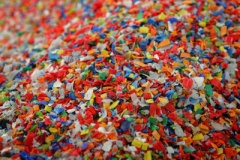Plastics
| Infobox on Plastics | |
|---|---|
| Example of Plastics |  |
| Facts | |
| Origin | - |
| Stowage factor (in m3/t) | - |
| Humidity / moisture | - |
| Ventilation | - |
| Risk factors | See text |
Plastics
Description / Application / Shipment and storage / Risk factors
Plastic materials which become contaminated with dust, dirt, etc., may, if such foreign matter cannot be separated, become useless for the production of high-grade articles. When this material is in dried form, moulding powders, etc., and is packed in paper bags, it is particularly liable to depreciation by reason of the bags coming into contact with foreign substances. Care is necessary in handling damaged bags to avoid contamination of the unexposed portion of the contents. The following are individual comments on various plastic materials for guidance in assessing the cause and extent of damage, and in the handling and treatment of plastic materials:
| The effect of damage by: | ||
| 1 | a) High humidity | |
| b) Salt water | ||
| c) Fresh water | ||
| d) Treatment, if any | ||
| 2 | a) Effect of damage by heat | |
| b) Treatment, if any |
Acetal Polymers
1. (a), (b) and (c): All three causes render material unsuitable for use.
(d) Vacuum drying would make material suitable for processing in case of (a) and (c) but not (b).
2. Melts at 165°C. Has a high thermal stability in air up to 100°C; will begin to degrade at approx. 190°C.
Acrylic Moulding Material
1. (a) and (c) Adversely affects processing and the general appearance of moulding.
(b) As for (a) but with additonal deterioration of electrical properties.
(d) Drying rectifies damage due to (a) and (c) but not that caused by (b).
2. (a) The product is not damaged by temperatures lower than 80°C
Acrylic Sheet
1. (a) No effect on the product, but the protective paper is subject to mould growth.
(b) and (c) Very little effect on the product itself, but water removes the protective paper coating and this leads to damage of the surface of the sheets.
2. (a) Temperatures above 50°C are liable to damage the surface protection and may also cause the sheets to warp. Damp storage conditions should be avoided.
Acrylonitrile Butadiene Styrene (ABS) Moulding Materials
1. (a), (b) and (c) Adversely affects moulding characteristics.
(d) By using a vacuum drying oven at 70°C material damaged by (a) and (c) may be made good for processing but not for (b).
2. (a) Material begins to soften at about 90°C and as temperature rises the granules will coalesce in the bags. Providing the material does not char (at approx. 160°C) it may be reground and used as scrap.
Acrylontrile Butadiene Styrene (AMS) Sheet
ABS sheet is not affected by water.
ABS sheet must not be subjected to loads at temperatures above 60°C as permanent deformation may occur.
Alkyd Moulding Resins
1. (a) Materials cannot be moulded satisfactorily. Electrical and mechanical properties seriously impaired or reduced to unacceptable levels.
(b) Material is irrecoverably damaged.
(c) Material cannot be moulded satisfactorily. Electrical and mechanical properties reduced to unacceptable levels. Powder forms aggregates.
(d) It is sometimes possible to recover part of the value of the material damaged under conditions (a) and (c) by reprocessing on the original manufacturing plant.
2. (a) Material hardens and is irrecoverably damaged. The material should be stored in a cool place below deck.
Cellulose Acetate, Cellulose Acetate Butyrate and Celulose Proprionate Moulding Material
1. (a) Would need to be pre-dried before moulding.
(b) Becomes useless as a moulding compound.
(c) Depends on the degree of saturation. If slight, pre-drying prior to moulding might make it serviceable. Immersion in water for any length of time would make it useless as a
moulding compound.
(d) (a) Drying. (b) None – doubtful whether there is any scrap value. (c) Drying or reprocessing.
Great care is taken in the manufacture of Cellulose Acetate and Cellulose Acetate Butyrate to avoid any kind of contamination from dust or moisture and any damage to the containers used for carrying the material could render it unsuitable for processing.
2. (a) Softens at about 50-90°C according to type. Would decompose around 240°C
Cellulose Acetate Sheet, Rod, Tube, Film, Foil, Profile Shapes
1. (a) Temporary effect: If 35% RH rising to 95% RH expansion of plastics 0,5% linear occurs; if properly packed no permanent distortion should result.
(b) and (c). If immersed for longer than a few minutes warping would ensue later and on drying out.
(d) Sea-water contamination would need washing off with clean water. Warped sheets could be flattened in presses. Film and badly warped shaped articles could be re-worked only as scrap.
2. (a) Heat up to 50°C, if not prolonged, and if articles properly packed, would not cause appreciable damage. If articles come under pressure from packing they may have surface markings impressed, or become distorted.
(b) Sheets can be repolished at the manufacturers’ factory. Exposed surfaces of some types of cellulose acetate plastics may develop mould on prolonged exposure to high humidity in warm climate. Stowage should be in a cool, dry place. Has very little surface static electrical effect. Although the surface hardness is not very high it is nevertheless quite man-resistant in service. When Cellulose Acetate and Cellulose Acetate Butyrate are brought into intimate contact with other plastics there is some danger of plasticizer migration which may have undesirable effects. Celluloid Sheet, Rod, Tube, Film, Foil, Profile Shapes 1. (a) Little effect (b) and (c) Damage to surface finish (d) Drying and reprocessing 2. (a) Is highly flammable.











